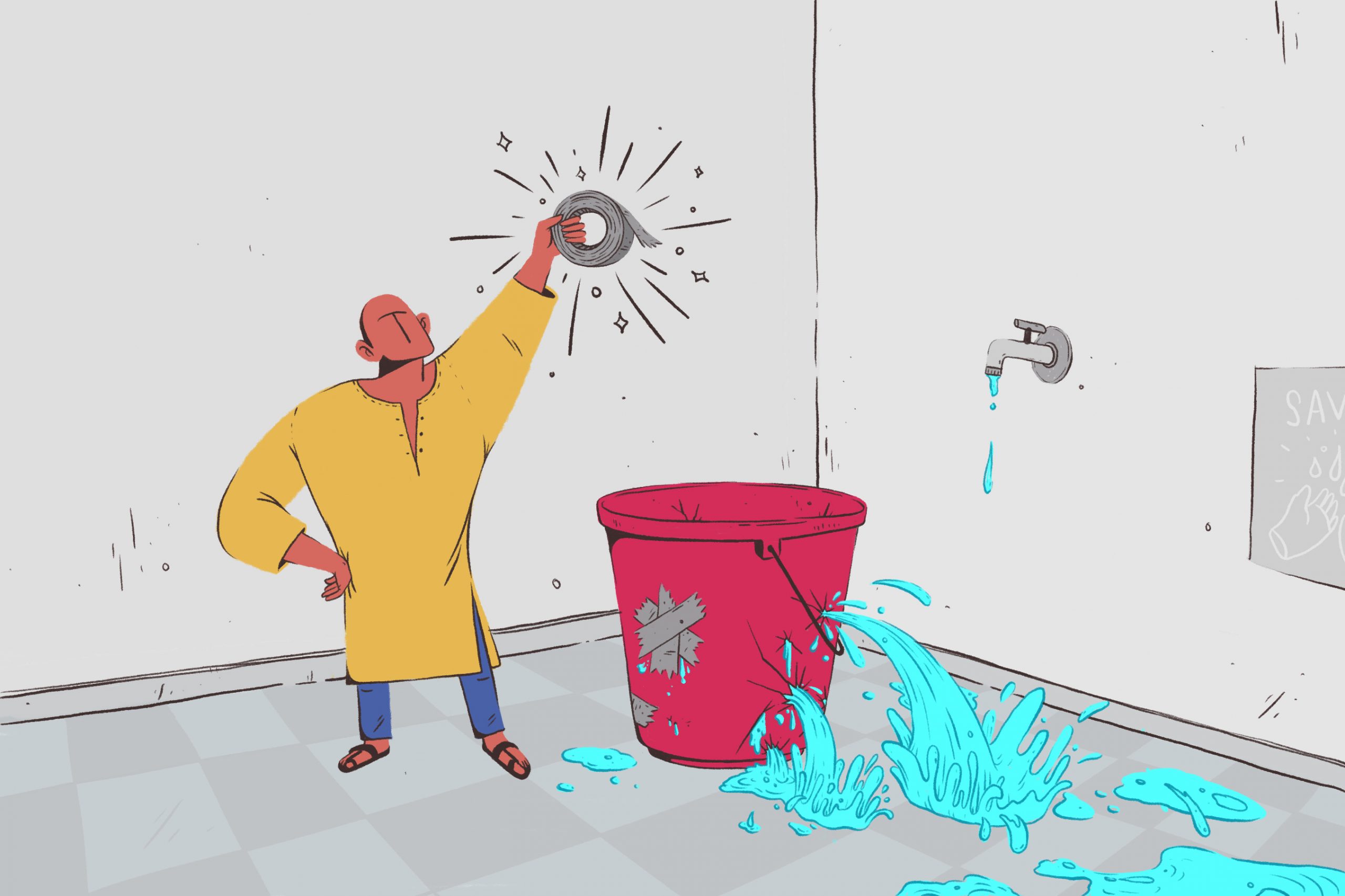In 1994, as part of my first assignment as a development consultant, I visited the nonprofit Association for Sarva Seva Farms (ASSEFA) in Vidarbha, Maharashtra. Back then, it was a well-known Gandhian organisation. We travelled to many villages, and in one we were invited to dinner at the home of Godutai Chowdhury. Godutai was a leader of a self-help group, and a poet. Upon being asked to sing her poems to us, she kindly obliged.
The first song was about goats. It told the story of how she would save small sums of money so she could get a loan to buy a couple of goats. She would then stay awake all night to guard them around the time of pola, which marked the end of the religious month of Shravan when all the men in Vidarbha villages would rejoice, get drunk, and gamble. She needed to protect her goats from her son, lest he sell them to buy alcohol. Her goats were important because they could earn her enough money to buy a little silver to marry her daughter. And so, on the song went.
Another poignant song told the story of a fictitious character; an irresponsible husband who made his wife slog at home, and then work on someone else’s farm the whole day. When she returned, he would beat her, drink heavily, and wet his dhoti. She sang about how while cleaning his mess she asked why god did not cause him to die. Listening to these songs, I later asked the project coordinator how common such situations were. “Quite common,” he said.
I wondered what, if anything, did their organisation do about such things? To which he replied that the true enemy was the liquor shop owner in the village. Their organisation encouraged the women to repeatedly complain to the police to close the shop. In some cases, women had ransacked the shop and thrown the fellow out, elsewhere they just complained. When I expressed my surprise over why the organisation didn’t do anything to these errant men who beat their wives or sold their goats to drink, he replied that the men were members of beneficiary groups as well. “How can we punish our own beneficiaries? We tell them what is right and what is wrong, but beyond that what can we do?”

Civil society’s efforts focus on championing rights and providing development solutions, but maintains a convenient blindspot towards creating a responsible citizenry | Illustration: Priya Dali
Through the decade and a half that I had taught at Institute of Rural Management Anand (IRMA), I had been hearing about the ethics of intervention—how external interveners imposed their value judgments on communities living in pristine harmony with nature. People typically held a contrasting view: “We should provide practical assistance to people but we cannot intervene in their lifestyle. What moral right do we have to do that?”
I wondered how far that logic would carry, particularly because lifestyles and customs are terms which are as flexible as rubber. What moral right do I have to tell high caste men not to oppress Dalits? What moral right do I have to tell parents not to send their children to work but to school? What moral right do I have to ask them not to marry their daughter at the age of 12?
Is attempting to right social wrongs responsible development work, or a hangover of the white man’s burden?
I wondered if we, as nonprofits, should stay passive observers of social ills. Or should we try to correct them? Is attempting to right social wrongs responsible development work, or a hangover of the white man’s burden?
A few years ago, I was participating in a meeting with a nonprofit that claimed to champion the rights of Adivasis. They talked of their heroic struggles and protracted legal battles fighting for the rights of the most vulnerable. Diverse aspects of their achievements, and the indicators for solidarity of the people and their collective strength were discussed.
At the end of a half day’s discussion, I asked them a few questions about whether the nearby highway had lured many of the women into the flesh trade; whether there were instances of almost forced participation in sex work; what the age at marriage for girls was; what the incidence of bigamy looked like. At first, they demurred, but I persisted. Their answers shocked me. Flesh trade was rife, there were several instances of nearly forced participation in sex work, bigamy was common, no property was ever in the woman’s name, and so on.
When all was admitted, I asked them why it had never occurred to them to pay attention to these aspects of social life while working with the Adivasis. One or two dared to say that this was not their agenda, instead they wished to work on saving the hills and the forests, and the tribal way of life. Realising that saying the plight of women was not their concern was an outrageous statement, their colleagues shushed them.
It became apparent that while they were carrying out their activism by blocking the roads and shouting slogans or getting arrested, they all felt like heroes. The enemy was outside, distant, and identifiable: the state, the forest guard, the capitalist. But when it came to looking at these sorts of questions, both the victims and perpetrators were from within the community they worked with; a large number of their tribal comrades who struggled with the state for their rights were the perpetrators of injustices within their homes.
When I brought this up, the nonprofit leaders thought it was crazy. But I was unrelenting: if they thought they were fighting for rights, then they had to be conscious of the rights of the women and fight for those too.
It helps to be a donor. We forced this agenda down their throat.
Making sense of civil society behaviour
These anecdotes raise diverse issues pertaining to the central point of responsible citizenship. I suspect that while setting a goal and moving towards it, nonprofits—like their business counterparts—too seek a path of least resistance. Often, the goals themselves are chosen in a manner that addresses some need of the people—whether directly felt by them, or presumed to exist by the organisation.
Fighting the state is easier than fighting orthodoxy in the community. Do nonprofits tend to avoid this because it is not convenient?
But as raised in these anecdotes themselves, these examples should lead to many questions. In the first example, is the enemy the liquor vendor or does the problem lie within the men? Does the nonprofit bear any responsibility in this matter, or does it amount to interference? For the second, why do even civil society organisations ignore aspects pertaining to women’s well-being? Is fighting the state easier than fighting orthodoxy in the community?
Responsible citizenship appears to involve changing habits and behaviours shaped by force of custom. Do nonprofits tend to avoid this task because it is not convenient to insist on it?
Towards conceptualising responsible citizenship
Behaviours get defined as responsible or otherwise in a social context. Polygamy does not defy norms of responsibility in one community, while it is seen as an irresponsible breach of behaviour in another. When a capitalist charges prices which the market can bear, the fact remains that their products and services remain beyond the physical, social, or financial reach of most people. It is quite fashionable to term the capitalist’s behaviour as ‘irresponsible’. Undoubtedly, there is a touch of arbitrariness in this. Clearly what one decides as ‘responsible’ or ‘irresponsible’ depends on what social values one upholds.
It is perhaps small solace that the so-called rights of citizens are as much a product of social values as is the concept of responsibility. Rights are defined within a framework of institutions—social, legal, political, or economic—which are legitimised in society. For instance, the current Right to Education (RTE) Act guarantees a right to free education to all children between six and 14 years. But in the case of madrassas for instance, exempting them from the RTE because the institutions governing them might ordain so, would make for a weird situation: Muslim children who need the right to education the most will not have it.
We can view responsible citizenship through the lens of our constitution
Given that both rights and responsible citizenship are value-based, we will need a frame of reference through which we can look at the concept of citizen responsibility. I believe that the ideas in the Indian Constitution provide that framework: secularism, federalism, universal brotherhood and universal franchise, equality before law, and so on.
We can thus view responsible citizenship through the lens of our constitution, which defines what comprises our duties and responsibilities towards each other and towards society.
Civil society and civic responsibility
Civil society organisations including nonprofits have helped instill a sense of empathy in the fortunate for the less fortunate, build a spirit of solidarity in village communities, enhance a sense of responsibility among citizens whenever they have attempted to enable communities to address their problems on their own, and so on.
Yet, there has been a dearth of civil society action in promoting responsible citizenship because this has taken a back seat to championing the ‘rights’ of the people.
I am concerned that in the zeal to work towards ‘protecting and furthering’ rights of individuals, civil society action is failing to tell their clients that they too have a responsibility; and without bearing it, their fight for rights can only make matters worse.
Grandstanding to show that one is championing citizens’ rights is far shallower than making the same citizens more responsible.
This is because the actions needed to protect a set of rights of one set of individuals while guarding another set of rights of a different set of individuals are complex and often in conflict with one another. In claiming supremacy of individual rights over civic responsibilities, civil society is unwittingly contributing to shaping a society that demands the government deliver on people’s rights, while failing to contribute towards building a vibrant, strong, and resilient nation. Thus, to me, grandstanding to show that one is championing citizens’ rights is far shallower than making the same citizens more responsible.
Work connected with civic responsibilities has to do with persuading the community to forego certain gains or pay up for their usage of public goods (for example, convincing farmers not to deepen borewells to irrigate a thirsty crop in the same village where their organisation is trying to conserve and recharge ground water). Doing this thus involves making people give up, forsake, abstain. Not only is this an unattractive task, but it also simply cannot be achieved unless one has established a close rapport and an equation of deep mutual respect with the community.
Further yet, it may need civil society individuals and institutions to forsake, give up, abstain. After all, why should people listen to me if they do not see me practicing what I preach? And even if they know I am practicing what I preach, why should they listen to me unless they have a deep respect for me? And how can I achieve that respect except by working for their benefit?
The rights-based approach and responsible citizenship cannot coexist
The rights discourse tends to imply that citizens have only rights and all the responsibility vests in the state. The responsibility discourse states that citizens have rights bounded by the rights of others, and that together they share with the state, the responsibility of collective well-being. In placing the onus on the state alone, we deny the existence of local institutions; and we completely forget the responsibility of the community, the local political structure, and the local elite in protecting the interests of the disenfranchised.
Citizens have rights bounded by the rights of others, and together, along with the state, they share the responsibility of collective well-being.
The state can only work through individuals: the teacher, the anganwadi worker, the Public Health Centre (PHC) nurse, the forest guard, and so on. Given the way the bureaucratic state apparatus operates, none of these people find it any longer necessary to treat themselves responsible to the local community. This is because their salary and service conditions are governed by the officers at the district level, who may not heed the community at all. And poor governance ensures that local workers can get away without performing their services and with no recourse available for the disenfranchised.
The civic responsibility model on the other hand would perhaps work to make the local community responsible for ensuring that each one is provided for.
The questions that we must now ask are: Is the task of building responsible citizenship understood at all? How has it been attempted? Can we learn anything from these examples? Is it desirable to work towards building a civil society oriented towards creating responsible citizenship? And finally, should donors attempt to take up the cause of building responsible citizenship as an agenda?





